The Article
Lenco L-3808 Turntable: Direct Drive on a Budget
24th May 2017
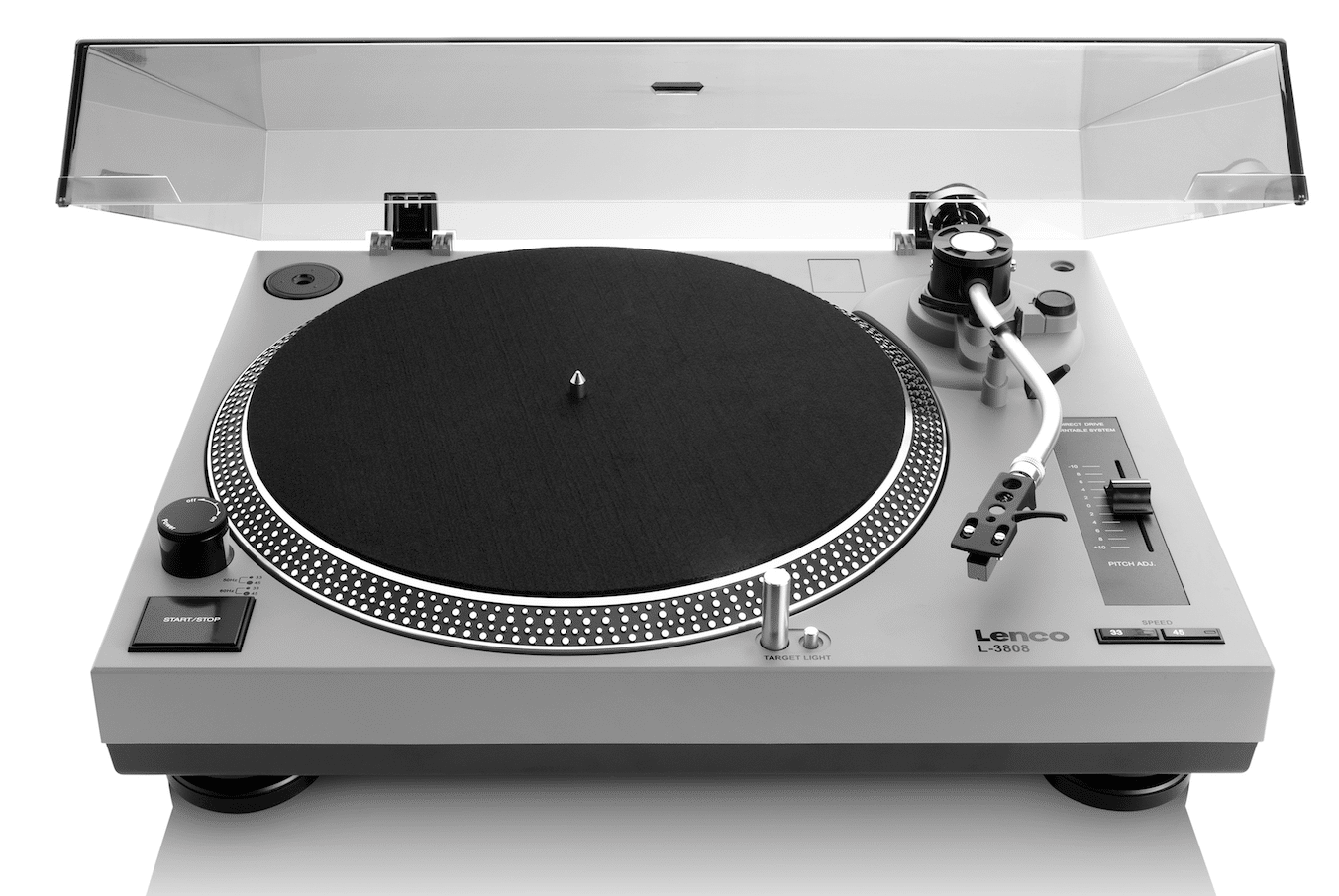
Want to go direct drive but are afraid of the expense? Lenco might have a surprise for you. Paul Rigby reviews the Lenco L-3808 (and provides a money off deal: see the end of the review)
Right, take a quick look at the price point below and then take a gander at the images and you just know that Made In China or similar is hidden somewhere within the chassis of this Lenco design. At this point the analogue snobs will lift their nose and leave the room. Still here? I’m glad, because this little turntable has a few surprises in store.
But what about that strobe light and pop-up light (for DJ use) that will immediately warn you that this might be a sad little Technics 1200 rip off? In this case, first impressions are very wrong indeed (although the turntable is recommended as an effective budget DJ tool, that’s true).
The construction is relatively solid for this price point with an all up weight of 5.4kg (the competing Dual MTR-75 weighs in at 4kg, for example).
The unit arrives with a dust cover but I would recommend removing it during play to avoid noise from its rather shaky mounting. By all means put it back, in place, when your listening session in over to protect from the dust.
The S-shaped arm looks and feels flimsy and small but it is secured well with an arm lock to prevent accidents. At the end of the arm is a removable headshell containing a standard (for this price) Audio Technica AT-3600 cartridge which Lenco asks you to run at a tracking force of 2g. Interesting because Dual, via its MTR-75 turntable, requests that you run exactly the same cartridge at around 3.25g! I know which one I’d rather place in my vinyl grooves! If you do buy yourself this deck, upgrade to a better cartridge ASAP. Something non-conical too which will enhance detail retrieval and the sonics immeasurably.
A manual turntable, beginners will be happy to see an arm lift which worked easily and well. An included moving magnet phono stage (which appears to be similar to that featured in the Dual MTR-75) is fitted within the chassis to save costs and to enable you to connect the deck to an amplifier’s line input or powered speakers. It can be switched to accept an external phono amplifier too, something that I would highly recommend as soon as you can afford one to further increase sound quality. A USB digital output is also present that can be used with the included Audacity music editing software to enable digital recording of your analogue discs. A mains cable is pre-fitted to the turntable.
IN USE
I found that, playing the turntable at 33.33, I did have to move the pitch adjustment just a tad from the default ‘0’ postion, to correct a slight speed drop.
OK, there’s no quartz control connected to the direct drive motor here, so you can’t expect nailed on speed control but it ain’t too bad once you get to grips with the pitch adjustment. The 8-pole, 2-phase design does a decent job considering the price.
Apart from that, the Lenco sprang into life without any issues.
SOUND QUALITY
I began the sound tests playing a selection of the 80s minimalist synth outfit, Bizarre Unit, combining vocals, sparse early synths with organic instruments
One of the principle failings of the budget turntable – even more so the sub-budget table – is how very much out of control it is in terms of assembling and presenting diverse frequencies to your ear. Just about everything that can go wrong normally will: blooming bass, smearing midrange and faltering stereo image with a flat soundstage and no character to any of the instruments. The Lenco addresses many of these failings from the core of one single feature: it’s direct drive motor. This single, yet essential, feature gives the turntable that one essential weapon in its sonic armoury, control. Because of the direct drive motor, there is far more focus and precision in terms of overall presentation than you would normally expect at the low, low price point.
Apart from the stereo image being rock solid and central, the bass was noticeably heavier than normal with a heft and weight that added significant presence to the entire track. Drums were meaningful and full of character, giving a foundation to the music that moved it forward at a steady pace while the midrange was, for the price, so accurate it actually created air and space in the soundstage, allowing more vocal reverb to be ‘visible’. This accuracy also infused the electric guitar with a sense of extra speed, as the transient performance improved immeasurably. The bass guitar also had more form and character. The vocals – both male and female – exuded emotion but also the delivery provided new details and nuance while the synths stopped spewing their smearing frequencies over everywhere and kept themselves to themselves. They no longer tried to mask subtle details, giving the music a richer flavour.
I then moved to the jazz vocal of Gogi Grant and the track By Myself, from the 1960 LP, Granted It’s Gogi on Living Stereo.
Grant’s wide ranging and dynamic vocal needs space and air to expand into and the Lenco, considering it’s low price point, certainly offered that. Grant fairly sparkled into a stereo image that pushed backwards as a 3D effect, allowing her big band orchestra to play around her. The focus upon her vocal allowed the ear to follow each element of her delivery with some ease.
The brass offered no brightness or stridency but, instead, had a texture through the vibrational effects of the performance giving an admirably brassy tone to this section of the backing band while keeping a measure of reverb to add energy to its effect.
Bass, from this direct drive, bounced and responded splendidly. The double bass having a notable sense of power and control on the early parts of this track. Percussion was particularly successful off this track. Partly, because the precise treble performance allowed the cymbals to offer both delicacy but also accuracy.
CONCLUSION
It’s not perfect – how can it be at £200? This is a sub-budget design so the myriad of tiny design quirks can and should be forgiven. The sound quality, meanwhile, is absolutely superb. A real shocker because it really shouldn’t be at this low, low, price. The Lenco is a solid (in plastic terms, at any rate), great sounding and easy to use turntable. A top class budget performer and a brilliant choice for anyone wanting to enter the vinyl fray.
LENCO L-3808 TURNTABLE Price: £200 Tel: 0333 1234 603 Website: www.lencouk.com TO BUY CLICK BELOW: UK - https://amzn.to/35TNWIA EUROPE - https://amzn.to/35ZtSV4
GOOD: precision, focus, ease of use, bass, price, direct drive
BAD: slight initial speed adjustment required
RATING: 9
REFERENCE
Dual MTR-75 turntable
Trichord Dino phono amplifier
Rega Brio-R amplifier
Spendor S3/5R speakers
Tellurium Q cabling
Harmonic Resolution Systems Noise Reduction Components
All vinyl was cleaned using an Audio Desk’s Ultrasonic Pro Vinyl Cleaner

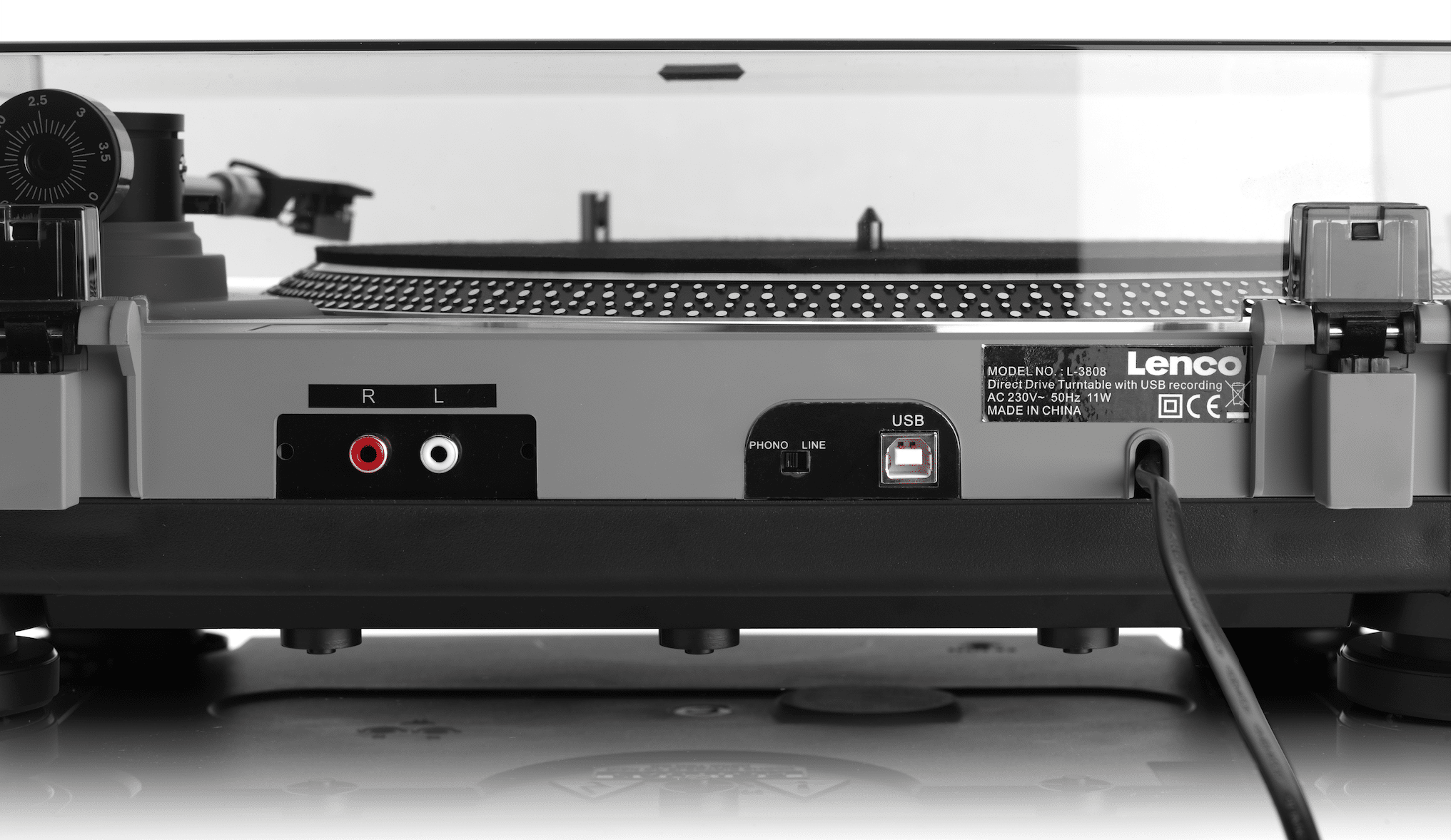
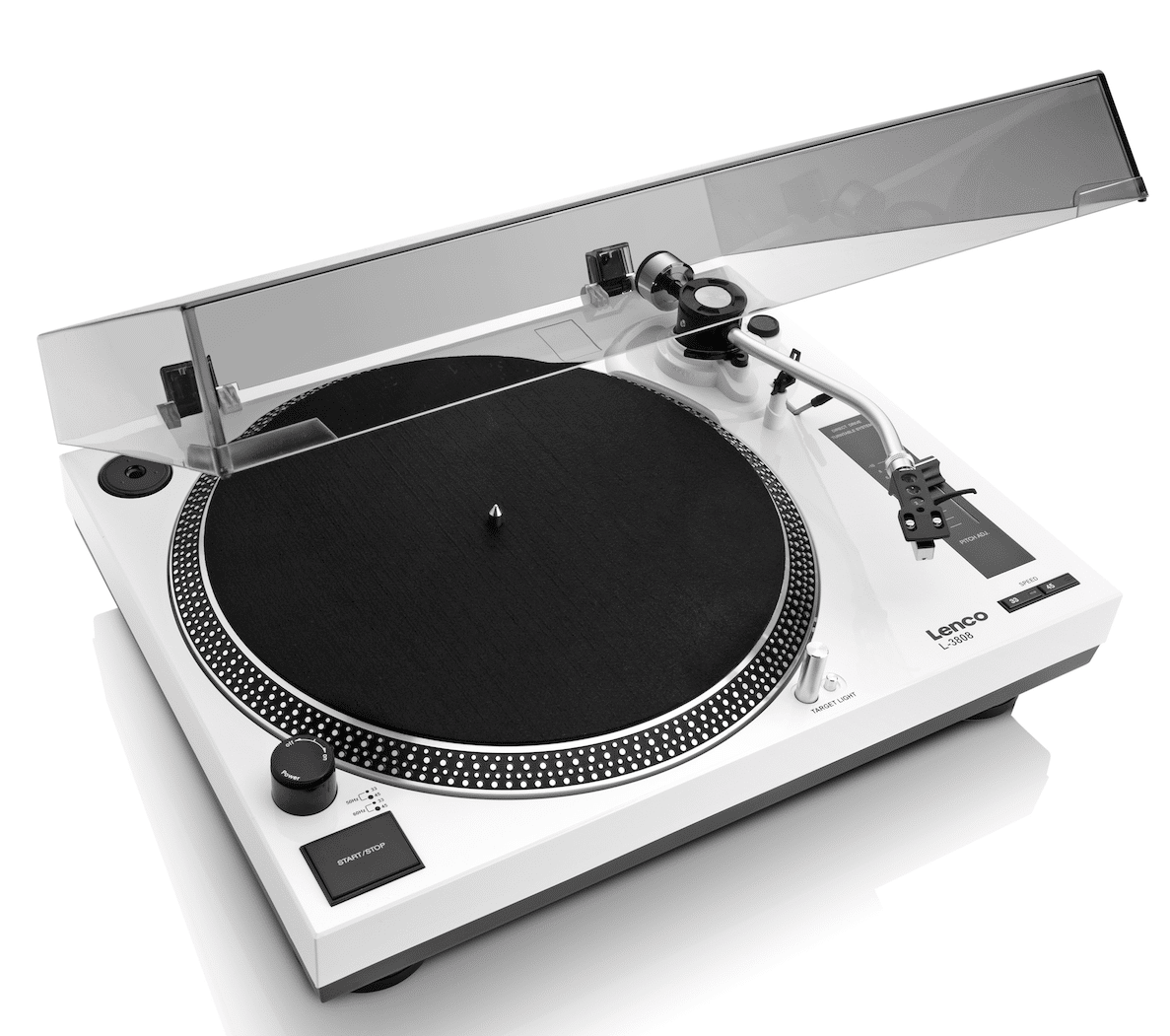
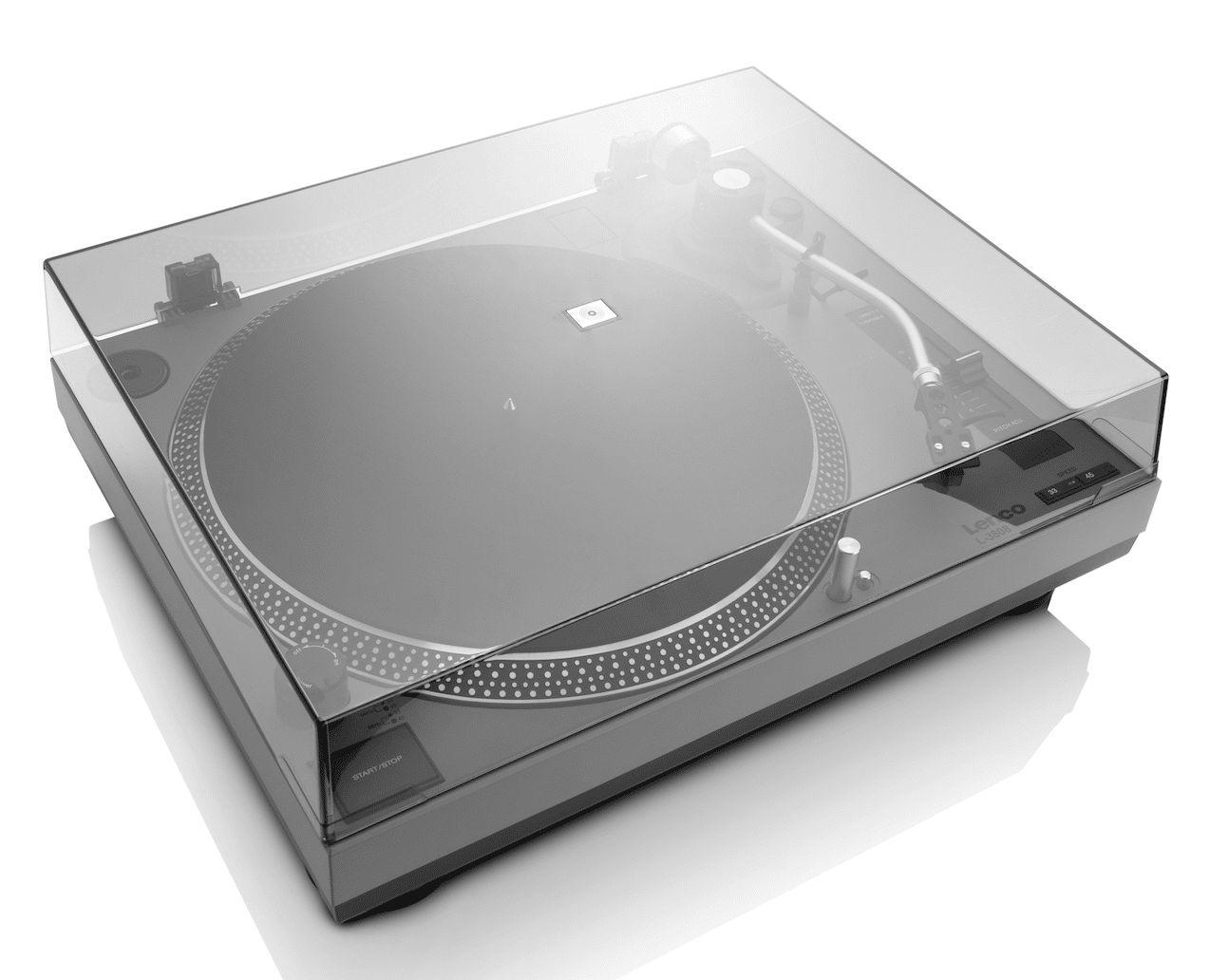
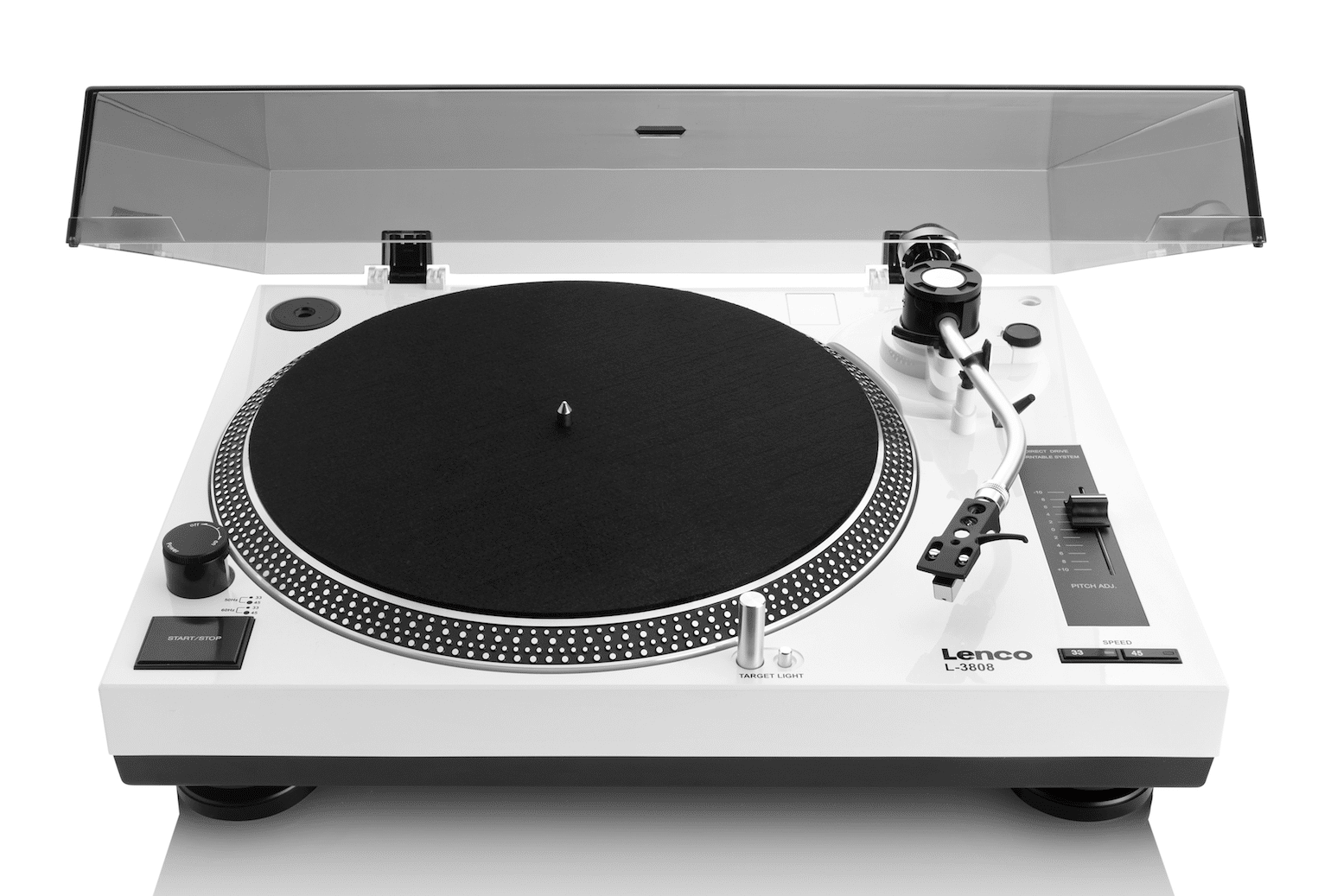
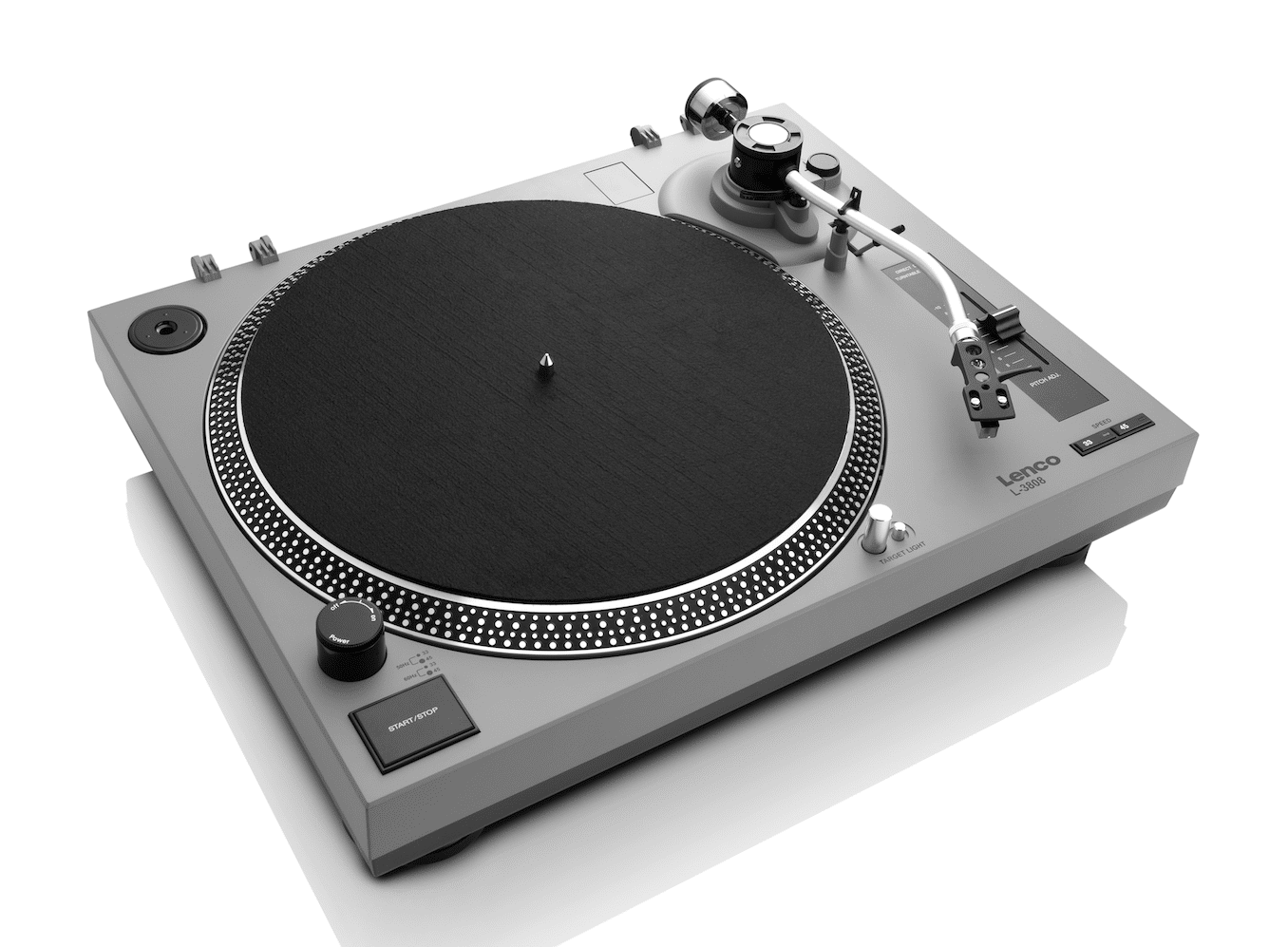


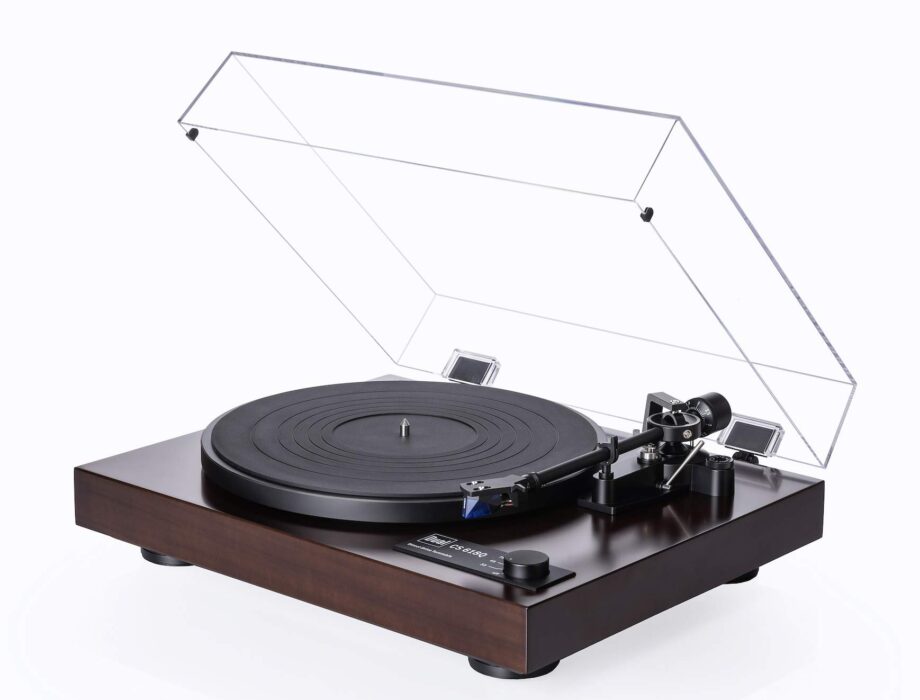
Hi, very nice review, thank you. One question: is ot worth to spend about 50€ more in the Audio Technica LP120?
The LP120 gives you a 78rpm option, forward/reverse platter motion (good for DJs) and a better cartridge. Unless the first two are important, then stick with the Lenco and upgrade the cartridge yourself. Have you looked at the company’s current sale?
Thanks again! I supossed that maybe the AT motor would be better than Lenco, or maybe the built in amp, but for your words i guess they both come from the same factory, could be? For me, only the better cartridge is the main difference, so 99% i will buy Lenco.
I didn’t see tue company’s offer, i will check right now, but i live in spain and maybe it doesn’t apply here
Thanks
Hi again. Finally i got an offer here in Spain and i bought tje Audio Technica ATLP120 for 210‚Ǩ. I set it up and i’m glad with it, but yesterday i found a noise from the motor, when playing without vinyl on the plate. I found a video in YouTube with the same issue (https://youtu.be/YxVa8THzAEA) i’m planning on return the turntable and buy the lenco, do you think that noise is normal?
I haven’t reviewed that one, Martin but I would say ‘no’ to the noise being normal and would recommend a return to the place of origin.
Hi Paul
I just purchased the Lenco L-3808 and set it up only to be quite disappointed with the sound quality. I actually was thinking it might have been the built-in pre-amplifier however after reading your review I’m wondering if it’s the supplied cartridge.
My previous turntable (sadly lost to a fire) was ultra bugdet (c £80 in 2008) and sounded much better.
You’ve given many recommendations on replacement styluses above but I’m a little lost on what is actually inferior. Do I just need to replace the stylus? Cartridge? Or the entire headshell? What’s the best way to do this without spending another fortune!
Hi Lee – you need to change the entire cartridge. Keep the headshell. This one would do nicely: https://eu.audio-technica.com/hifi-phono/cartridges/AT95E
I think you can pick it up on Amazon or just about any hi-fi retailer for around £36 or less. If you use an external phono amp then sound quality will rise further, yes. The Rega Fono is a nice model at around £89.
This may also be of use – depending on the quality of your shelving and isolation: https://theaudiophileman.com/elusive/
Nice find, Paul. Is this the same as the Reloop RP-2000-M? Lenco turntables aren’t sold in America. Thank you.
http://www.reloop.com/reloop-rp-2000m
Hi Joel
No, the Reloop is a different kettle of fish. The Reloop offers a much more superior design. Saying that, for the money, there are better turntables out there than the Reloop.
Hi Paul, Thank you for the thorough review, it made me choose the L-400BK (which is a black version of the L-3808 Lenco made exclusively for Media Markt) and ordered an AT95E along with it. I was wondering if the weight of the headshell cartrigde does anything for sound quality and/or stability during playback? The headshell cartridge of my previous turntable weigh 3 grams more than the headshell cartridge provided by Lenco (I know I have to adjust the counterweight if I change between the two). I also find the arm on the headshell of my previous TT a bit easier to hold on to (I have rather large hands). Do you reckon I’d install the AT95E on the old headshell and keep the AT3600 on the headshell by Lenco as a spare/back-up?
Hi Paul – thanks for your question and well worth asking. Sound quality will rely less on actual weight (which, as you say, tends to be balanced out by the arm anyway) than the rigidity of the headshell itself. Which is why you can upgrade headshells to the likes of this: http://www.hifisound.co.uk/analogue-c49/tonearm-zone-c3/headshells-leads-tags-c37/at-lh18-occ-18g-technihard-adjustable-headshell-p1063/s1723?utm_source=google&utm_medium=cpc&utm_term=audio-technica-at-lh18-occ-18g-technihard-adjustable-headshell-at-lh18-occ&utm_campaign=product+listing+ads&gclid=EAIaIQobChMI0fS4y52C2QIVQrcbCh2_aQuxEAQYBSABEgLZmfD_BwE
or this: https://www.divineaudio.co.uk/jelco-hs25-headshell
You don’t tell me much about your older headshell but I would use the model which is the most rigid of the two. If they are the same, then just use the one you’re most comfortable with.
Hi Paul, thank you for the swift reply. My old headshell is a Numark HS1. It is made out of metal, which I would reckon is more rigid than the plastic one that came with the Lenco.
https://imagescdn.juno.co.uk/full/IS223427-01-01-BIG.jpg
Hi Paul – that sounds promising. Go for that one.
Hi Paul, will do. Thank you very much for the advice.
Hi, I am getting back into vinyl after a very long time….I have this turntable and would be grateful for some advice on speakers to get the best out of it.
What amp are you using Jo? And what is your budget re the speakers?
Hi Paul, I bought the Lenco L-3808 turntable after reading your review a couple of month ago. However I have the problem that the needle skips when cueing. I tried already different tracking forces from 2.5g to 4g, but this only helps a little. What do you think is right? Also I am thinking about changing the cartridge to a Shure M447, as I read they are great and hardly skip. What would you suggest? Is it just my wrong setup or should I change the whole cartridge?
Hi Sebastian – thanks for your question. Can I ask, have you correctly set the anti-skate?
Yes, I think so, I set the anti-skate at first at the same weight as the tracking force. However I read that it should be set at 0, so the needle doesn’t skip when cueing or scratching. I tried that and it helps a little, but it still skips quite often.
Hi Sebastian – you only need to set the anti-skate to zero when you’re initially setting the tracking force. The anti-skate employs a force upon the arm you see. Hence, setting the anti-skate to zero removes that force, stopping the tonearm being pulled about while you’re concentrating on the tracking force duties. You set the tracking force. You then set the anti-skate to the same setting as the tracking force.
A few questions for you.
How did you measure the tracking force, by the way? What tool did you use? I’d always recommend setting the tracking force with a tool rather than winging it (which Lenco likes to advise). Here’s a decent example for under a tenner: https://www.amazon.co.uk/Neoteck-Digital-Turntable-Backlight-Cartridge-Black-Black/dp/B01GJ01FGM/ref=sr_1_1?ie=UTF8&qid=1518349642&sr=8-1&keywords=tracking force
One other point, from memory (it’s been a while), Lenco asks you to put the counterweight on the rear of the arm, then to move it so that the tonearm freely balances, then you set the measuring ring on the front of the counterweight to ‘0’. Then you move the counterweight to 2g for the recommended tracking force (I think it’s 2g) This moves the front ring too, of course. That last bit, moving the counterweight to 2g, did you actually move the *counterweight* only all the way to 2g or did you only move the *ring* bit to 2g? Or did you grab both and move both the ring and counterweight with your fingers?
Did you follow the manual slowly and carefully when setting the tracking force/anti-skate?
I sense a little confusion in there somewhere.
Thanks for your quick response. I actually set the counterweight as you and the manual explained. I just tried different tracking forces from 2g recommended by Lenco, to 4g which I read is recommended for the AT 3600 cartridge. Maybe I should clarify, I don’t have any problems when just playing vinyl, only when I try to mix, moving the vinyl back and forth for finding the cue-point. Then the needle skips. So I read in some forums that for scratching anti-skate should be set to 0. That is why I thought maybe the cartridge is just not made for djing and I should buy something like the Shure M447. Sorry if it is a bit confusing, but thanks for your help so far!
Ahhhh, light dawns 🙂 I wouldn’t use the included cart for DJ work. Even if it was suitable, the spherical stylus itself will not get the best from your vinyl in terms of the message you’re trying to put across.
Check out the new Ortofon Concordes here https://theaudiophileman.com/concorde-mkii-cartridge-ortofon/
And the official ‘chart’ here: https://www.ortofon.com/dj/products/dj-cartridges
The Shure you mentioned is a good one too. As the company says “Skip Resistance: ultra high” 🙂
Hi Paul,
Thanks for all informations.
I bought L 3808 and not so happy with the sound.
Connected to my Yamaha Mixer with amplifier
the result is not so good. When I raise the volume, bass hums.
I want to replace my Lenco 3808 cartridge.
Can you tell me which one I should buy for best results ?
AT95E or OM3E or Shure M447
Thanks for your help
Hi Nebil
Difficult to tell at this distance but it shouldn’t be humming in the bass region. Not at all. A replacement cartridge won’t alter that either. Sounds like something mechanical. As such, I would advise looking at your cables and connections and checking those carefully. I wonder if you might have an earthing issues there. Also, that mixer – why do you need a mixer? Is it for DJ purposes? I wonder if the answer might lie there. In terms of fine detail, though, once the hum has been removed, you need to change the cart, as I advised in the review. The AT95E would be a good choice.
Hi Paul,
Thanks for quick reply and advices.
I will check all connections again and better change the cables.
Might the humming be depending on the room size ? Or Ohm value of speakers ?
I have big wharfedale speakers with 200 Watts power each.
I have good earthing. The mixer I use in my house is for
singing and recording (not professional).
In any case I will replace the cartridge with AT95E.
Hope to receive better sound.
Hi Nebil – I would say no to your suggestions. Please check the earthing re the turntable – I would remove all cables and push them back firmly. I would also look at where the turntable is cited. The cartridge might be interfering with something else. Look for other products with magnets in them, basically. Also, is the phono switch on the back of the turntable in the correct position? What is the turntable plugged into?
Hi Paul,
Thanks for reply.
There is no earthing point in lenco where I can connect a cable.
The turntable is close to TV.
The phone switch is in line mode because my mixer doesn’t have
any phone input, only line input.
I tried to connect to phono input of my Marantz Amplifier,
the sound was better but there was a small deep sound because
there is no connection place for grounding on Lenco.
Hi Nebil – if the switch is in Line mode, you need to connect the turntable directly to a phono amplifier, not a mixer. Have you done this? You can connect the turntable to the Marantz’s phono sockets but then you need to switch the Lenco to Phono mode.
Oh OK I understand.
When I connect the turntable to the Marantz phono sockets
while Lenco is switched to Phono Mode, the sound quality is better,
but there is disturbing dip sound when I turn on the lenco.
Hi Nebil – ok, so the Lenco is in Phono mode when connected to the Marantz? And you’re definitely in the amp’s Phono sockets and not elsewhere? Does the dip (when you say ‘dip’ do you mean a towering in volume?) only occur on switch on and then it’s fine from then on?